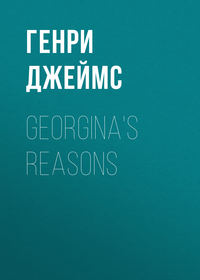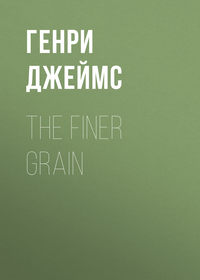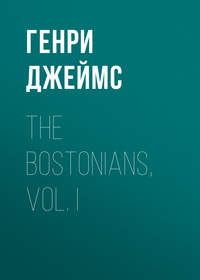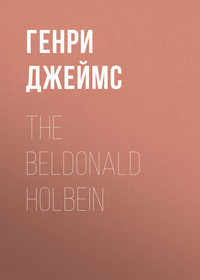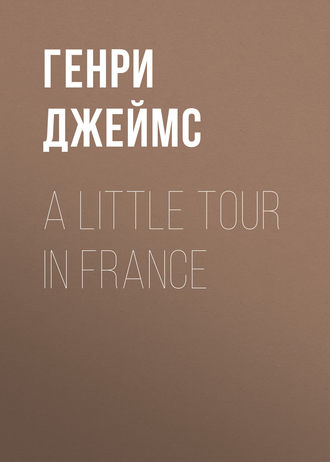 полная версия
полная версияA Little Tour in France

Henry James
A Little Tour in France
We good Americans – I say it without presumption – are too apt to think that France is Paris, just as we are accused of being too apt to think that Paris is the celestial city. This is by no means the case, fortun- ately for those persons who take an interest in modern Gaul, and yet are still left vaguely unsatisfied by that epitome of civilization which stretches from the Arc de Triomphe to the Gymnase theatre. It had already been intimated to the author of these light pages that there are many good things in the doux pays de France of which you get no hint in a walk between those ornaments of the capital; but the truth had been re- vealed only in quick-flashing glimpses, and he was conscious of a desire to look it well in the face. To this end he started, one rainy morning in mid-Septem- ber, for the charming little city of Tours, from which point it seemed possible to make a variety of fruitful excursions. His excursions resolved themselves ulti- mately into a journey through several provinces, – a journey which had its dull moments (as one may defy any journey not to have), but which enabled him to feel that his proposition was demonstrated. France may be Paris, but Paris is not France; that was perfectly evident on the return to the capital.
I must not speak, however, as if I had discovered the provinces. They were discovered, or at least re- vealed by BaIzac, if by any one, and are now easily accessible to visitors. It is true, I met no visitors, or only one or two, whom it was pleasant to meet. Throughout my little tour I was almost the only tourist. That is perhaps one reason why it was so successful.
I
I am ashamed to begin with saying that Touraine is the garden of France; that remark has long ago lost its bloom. The town of Tours, however, has some thing sweet and bright, which suggests that it is sur- rounded by a land of fruits. It is a very agreeable little city; few towns of its size are more ripe, more complete, or, I should suppose, in better humor with themselves and less disposed to envy the responsibili- ties of bigger places. It is truly the capital of its smil- ing province; a region of easy abundance, of good living, of genial, comfortable, optimistic, rather indolent opinions. Balzac says in one of his tales that the real Tourangeau will not make an effort, or displace him- self even, to go in search of a pleasure; and it is not difficult to understand the sources of this amiable cynicism. He must have a vague conviction that he can only lose by almost any change. Fortune has been kind to him: he lives in a temperate, reasonable, sociable climate, on the banks, of a river which, it is true, sometimes floods the country around it, but of which the ravages appear to be so easily repaired that its aggressions may perhaps be regarded (in a region where so many good things are certain) merely as an occasion for healthy suspense. He is surrounded by fine old traditions, religious, social, architectural, culi- nary; and he may have the satisfaction of feeling that he is French to the core. No part of his admirable country is more characteristically national. Normandy is Normandy, Burgundy is Burgundy, Provence is Pro- vence; but Touraine is essentially France. It is the land of Rabelais, of Descartes, of Balzac, of good books and good company, as well as good dinners and good houses. George Sand has somewhere a charm- ing passage about the mildness, the convenient quality, of the physical conditions of central France, – "son climat souple et chaud, ses pluies abondantes et courtes." In the autumn of 1882 the rains perhaps were less short than abundant; but when the days were fine it was impossible that anything in the way of weather could be more charming. The vineyards and orchards looked rich in the fresh, gay light; cultivation was everywhere, but everywhere it seemed to be easy. There was no visible poverty; thrift and success pre- sented themselves as matters of good taste. The white caps of the women glittered in the sunshire, and their well-made sabots clicked cheerfully on the hard, clean roads. Touraine is a land of old chateaux, – a gallery of architectural specimens and of large hereditary pro- perties. The peasantry have less of the luxury of ownership than in most other parts of France; though they have enough of it to give them quite their share of that shrewdly conservative look which, in the little, chaffering, place of the market-town, the stranger ob- serves so often in the wrinkled brown masks that sur- mount the agricultural blouse. This is, moreover, the heart of the old French monarchy; and as that monarchy was splendid and picturesque, a reflection of the splen- dor still glitters in the current of the Loire. Some of the most striking events of French history have occurred on the banks of that river, and the soil it waters bloomed for a while with the flowering of the Renais- sance. The Loire gives a great "style" to a landscape of which the features are not, as the phrase is, promi- nent, and carries the eye to distances even more poetic than the green horizons of Touraine. It is a very fit- ful stream, and is sometimes observed to run thin and expose all the crudities of its channel, – a great defect certainly in a river which is so much depended upon to give an air to the places it waters. But I speak of it as I saw it last; full, tranquil, powerful, bending in large slow curves, and sending back half the light of the sky. Nothing can be finer than the view of its course which you get from the battlements and ter- races of Amboise. As I looked down on it from that elevation one lovely Sunday morning, through a mild glitter of autumn sunshine, it seemed the very model of a generous, beneficent stream. The most charming part of Tours is naturally the shaded quay that over- looks it, and looks across too at the friendly faubourg of Saint Symphorien and at the terraced heights which rise above this. Indeed, throughout Touraine, it is half the charm of the Loire that you can travel beside it. The great dike which protects it, or, protects the country from it, from Blois to Angers, is an admirable road; and on the other side, as well, the highway con- stantly keeps it company. A wide river, as you follow a wide road, is excellent company; it heightens and shortens the way.
The inns at Tours are in another quarter, and one of them, which is midway between the town and the station, is very good. It is worth mentioning for the fact that every one belonging to it is extraordinarily polite, – so unnaturally polite as at first to excite your suspicion that the hotel has some hidden vice, so that the waiters and chambermaids are trying to pacify you in advance. There was one waiter in especial who was the most accomplished social being I have ever encountered; from morning till night he kept up an inarticulate murmur of urbanity, like the hum of a spinning-top. I may add that I discovered no dark secrets at the Hotel de l'Univers; for it is not a secret to any traveller to-day that the obligation to partake of a lukewarm dinner in an overheated room is as imperative as it is detestable. For the rest, at Tours, there is a certain Rue Royale which has pretensions to the monumental; it was constructed a hundred years ago, and the houses, all alike, have on a moderate scale a pompous eighteenth-century look. It connects the Palais de Justice, the most important secular building in the town, with the long bridge which spans the Loire, – the spacious, solid bridge pronounced by Balzac, in "Le Cure de Tours," "one of the finest monuments of French architecture." The Palais de Justice was the seat of the Government of Leon Gambetta in the autumn of 1870, after the dictator had been obliged to retire in his balloon from Paris, and before the Assembly was constituted at Bordeaux. The Germans occupied Tours during that terrible winter; it is astonishing, the number of places the Germans occupied. It is hardly too much to say that wherever one goes in, certain parts of France, one encounters two great historic facts: one is the Revolution; the other is the German invasion. The traces of the Revolution remain in a hundred scars and bruises and mutilations, but the visible marks of the war of 1870 have passed away. The country is so rich, so living, that she has been able to dress her wounds, to hold up her head, to smile again; so that the shadow of that darkness has ceased to rest upon her. But what you do not see you still may hear; and one remembers with a certain shudder that only a few short years ago this province, so intimately French, was under the heel of a foreign foe. To be intimately French was apparently not a safeguard; for so successful an invader it could only be a challenge. Peace and plenty, however, have succeeded that episode; and among the gardens and vineyards of Touraine it seems, only a legend the more in a country of legends.
It was not, all the same, for the sake of this check- ered story that I mentioned the Palais de Justice and the Rue Royale. The most interesting fact, to my mind, about the high-street of Tours was that as you walked toward the bridge on the right-hand trottoir you can look up at the house, on the other side of the way, in which Honore de Balzac first saw the light. That violent and complicated genius was a child of the good-humored and succulent Touraine. There is something anomalous in the fact, though, if one thinks about it a little, one may discover certain correspondences between his character and that of his native province. Strenuous, laborious, constantly in felicitous in spite of his great successes, he suggests at times a very different set of influences. But he had his jovial, full-feeding side, – the side that comes out in the "Contes Drolatiques," which are the romantic and epicurean chronicle of the old manors and abbeys of this region. And he was, moreover, the product of a soil into which a great deal of history had been trodden. Balzac was genuinely as well as affectedly monarchical, and he was saturated with, a sense of the past. Number 39 Rue Royale – of which the base ment, like all the basements in the Rue Royale, is occupied by a shop – is not shown to the public; and I know not whether tradition designates the chamber in which the author of "Le Lys dans la Vallee" opened his eyes into a world in which he was to see and to imagine such extraordinary things. If this were the case, I would willingly have crossed its threshold; not for the sake of any relic of the great novelist which it may possibly contain, nor even for that of any mystic virtue which may be supposed to reside within its walls, but simply because to look at those four modest walls can hardly fail to give one a strong impression of the force of human endeavour. Balzac, in the maturity of his vision, took in more of human life than any one, since Shakspeare, who has attempted to tell us stories about it; and the very small scene on which his consciousness dawned is one end of the immense scale that he traversed. I confess it shocked me a little to find that he was born in a house "in a row," – a house, moreover, which at the date of his birth must have been only about twenty years old. All that is contradictory. If the tenement selected for this honour could not be ancient and em- browned, it should at least have been detached.
There is a charming description, in his little tale of "La Grenadiere," of the view of the opposite side of the Loire as you have it from the square at the end of the Rue Royale, – a square that has some preten- sions to grandeur, overlooked as it is by the Hotel de Ville and the Musee, a pair of edifices which directly contemplate the river, and ornamented with marble images of Francois Rabelais and Rene Descartes. The former, erected a few years since, is a very honor- able production; the pedastal of the latter could, as a matter of course, only be inscribed with the Cogito ergo Sum. The two statues mark the two opposite poles to which the brilliant French mind has travelled; and if there were an effigy of Balzac at Tours, it ought to stand midway between them. Not that he, by any means always struck the happy mean between the sensible and the metaphysical; but one may say of him that half of his genius looks in one direction and half in the other. The side that turns toward Francois Rabelais would be, on the whole, the side that takes the sun. But there is no statue of Balzac at Tours; there is only, in one of the chambers of the melancholy museum, a rather clever, coarse bust. The description in "La Grenadiere," of which I just spoke, is too long to quote; neither have I space for any one of the brilliant attempts at landscape paint- ing which are woven into the shimmering texture of "Le Lys dans la Vallee." The little manor of Cloche- gourde, the residence of Madame de Mortsauf, the heroine of that extraordinary work, was within a moderate walk of Tours, and the picture in the novel is presumably a copy from an original which it would be possible to-day to discover. I did not, however, even make the attempt. There are so many chateaux in Touraine commemorated in history, that it would take one too far to look up those which have been com- memorated in fiction. The most I did was to endeavor to identify the former residence of Mademoiselle Gamard, the sinister old maid of "Le Cure de Tours." This terrible woman occupied a small house in the rear of the cathedral, where I spent a whole morning in wondering rather stupidly which house it could be. To reach the cathedral from the little place where we stopped just now to look across at the Grenadiere, without, it must be confessed, very vividly seeing it, you follow the quay to the right, and pass out of sight of the charming coteau which, from beyond the river, faces the town, – a soft agglomeration of gardens, vine- yards, scattered villas, gables and turrets of slate- roofed chateaux, terraces with gray balustrades, moss- grown walls draped in scarlet Virginia-creeper. You turn into the town again beside a great military barrack which is ornamented with a rugged mediaeval tower, a relic of the ancient fortifications, known to the Tourangeaux of to-day as the Tour de Guise. The young Prince of Joinville, son of that Duke of Guise who was murdered by the order of Henry II. at Blois, was, after the death of his father, confined here for more than two years, but made his escape one summer evening in 1591, under the nose of his keepers, with a gallant audacity which has attached the memory of the exploit to his sullen-looking prison. Tours has a garrison of five regiments, and the little red-legged soldiers light up the town. You see them stroll upon the clean, uncommercial quay, where there are no signs of navigation, not even by oar, no barrels nor bales, no loading nor unloading, no masts against the sky nor booming of steam in the air. The most active business that goes on there is that patient and fruitless angling in, which the French, as the votaries of art for art, excel all other people. The little soldiers, weighed down by the contents of their enormous pockets, pass with respect from one of these masters of the rod to the other,as he sits soaking an indefinite bait in the large, indifferent stream. After you turn your back to the quay you have only to go a little way before you reach the cathedral.
II
It is a very beautiful church of the second order of importance, with a charming mouse-colored com- plexion and a pair of fantastic towers. There is a commodious little square in front of it, from which you may look up at its very ornamental face; but for purposes of frank admiration the sides and the rear are perhaps not sufficiently detached. The cathedral of Tours, which is dedicated to Saint Gatianus, took a long time to build. Begun in 1170, it was finished only in the first half of the sixteenth century; but the ages and the weather have interfused so well the tone of the different parts, that it presents, at first at least, no striking incongruities, and looks even exception- ally harmonious and complete. There are many grander cathedrals, but there are probably few more pleasing; and this effect of delicacy and grace is at its best toward the close of a quiet afternoon, when the densely decorated towers, rising above the little Place de l'Archeveche, lift their curious lanterns into the slanting light, and offer a multitudinous perch to troops of circling pigeons. The whole front, at such a time, has an appearance of great richness, although the niches which surround the three high doors (with recesses deep enough for several circles of sculpture) and indent the four great buttresses that ascend beside the huge rose-window, carry no figures beneath their little chiselled canopies. The blast of the great Revo- lution blew down most of the statues in France, and the wind has never set very strongly toward putting them up again. The embossed and crocketed cupolas which crown the towers of Saint Gatien are not very pure in taste; but, like a good many impurities, they have a certain character. The interior has a stately slimness with which no fault is to be found, and which in the choir, rich in early glass and surrounded by a broad passage, becomes very bold and noble. Its principal treasure, perhaps, is the charming little tomb of the two children (who died young) of Charles VIII. and Anne of Brittany, in white marble, embossed with sym- bolic dolphins and exquisite arabesques. The little boy and girl lie side by side on a slab of black marble, and a pair of small kneeling angels, both at their head and at their feet, watch over them. Nothing could be more perfect than this monument, which is the work of Michel Colomb, one of the earlier glories of the French Renaissance; it is really a lesson in good taste. Originally placed in the great abbey-church of Saint Martin, which was for so many ages the holy place of Tours, it happily survived the devastation to which that edifice, already sadly shattered by the wars of religion and successive profanations, finally succumbed in 1797. In 1815 the tomb found an asylum in a quiet corner of the cathedral.
I ought, perhaps, to be ashamed to acknowledge, that I found the profane name of Balzac capable of adding an interest even to this venerable sanctuary. Those who have read the terrible little story of "Le Cure de Tours" will perhaps remember that, as I have already mentioned, the simple and childlike old Abbe Birotteau, victim of the infernal machinations of the Abbe Troubert and Mademoiselle Gamard, had his quarters in the house of that lady (she had a speciality of letting lodgings to priests), which stood on the north side of the cathedral, so close under its walls that the supporting pillar of one of the great flying buttresses was planted in the spinster's garden. If you wander round behind the church, in search of this more than historic habitation, you will have oc- casion to see that the side and rear of Saint Gatien make a delectable and curious figure. A narrow lane passes beside the high wall which conceals from sight the palace of the archbishop, and beneath the flying buttresses, the far-projecting gargoyles, and the fine south porch of the church. It terminates in a little, dead, grass-grown square entitled the Place Gregoire de Tours. All this part of the exterior of the cathe- dral is very brown, ancient, Gothic, grotesque; Balzac calls the whole place "a desert of stone." A battered and gabled wing, or out-house (as it appears to be) of the hidden palace, with a queer old stone pulpit jutting out from it, looks down on this melancholy spot, on the other side of which is a seminary for young priests, one of whom issues from a door in a quiet corner, and, holding it open a moment behind him, shows a glimpse of a sunny garden, where you may fancy other black young figures strolling up and down. Mademoiselle Gamard's house, where she took her two abbes to board, and basely conspired with one against the other, is still further round the cathe- dral. You cannot quite put your hand upon it to- day, for the dwelling which you say to yourself that it must have been Mademoiselle Gamard's does not fulfil all the conditions mentioned in BaIzac's de- scription. The edifice in question, however, fulfils con- ditions enough; in particular, its little court offers hospitality to the big buttress of the church. Another buttress, corresponding with this (the two, between them, sustain the gable of the north transept), is planted in the small cloister, of which the door on the further side of the little soundless Rue de la Psalette, where nothing seems ever to pass, opens opposite to that of Mademoiselle Gamard. There is a very genial old sacristan, who introduced me to this cloister from the church. It is very small and solitary, and much mutilated; but it nestles with a kind of wasted friend- liness beneath the big walls of the cathedral. Its lower arcades have been closed, and it has a small plot of garden in the middle, with fruit-trees which I should imagine to be too much overshadowed. In one corner is a remarkably picturesque turret, the cage of a winding staircase which ascends (no great distance) to an upper gallery, where an old priest, the chanoine-gardien of the church, was walking to and fro with his breviary. The turret, the gallery, and even the chanoine-gardien, belonged, that sweet September morning, to the class of objects that are dear to paint- ers in water-colors.
III
I have mentioned the church of Saint Martin, which was for many years the sacred spot, the shrine of pilgrimage, of Tours. Originally the simple burial- place of the great apostle who in the fourth century Christianized Gaul, and who, in his day a brilliant missionary and worker of miracles, is chiefly known to modem fame as the worthy that cut his cloak in two at the gate of Amiens to share it with a beggar (tradition fails to say, I believe, what he did with the other half), the abbey of Saint Martin, through the Middle Ages, waxed rich and powerful, till it was known at last as one of the most luxurious religious houses in Christendom, with kings for its titular ab- bots (who, like Francis I., sometimes turned and despoiled it) and a great treasure of precious things. It passed, however, through many vicissitudes. Pillaged by the Normans in the ninth century and by the Huguenots in the sixteenth, it received its death-blow from the Revolution, which must have brought to bear upon it an energy of destruction proportionate to its mighty bulk. At the end of the last century a huge group of ruins alone remained, and what we see to-day may be called the ruin of a ruin. It is difficult to understand how so vast an ediface can have been so completely obliterated. Its site is given up to several ugly streets, and a pair of tall towers, separated by a space which speaks volumes as to the size of the church, and looking across the close-pressed roofs to the happier spires of the cathedral, preserved for the modern world the memory of a great fortune, a great abuse, perhaps, and at all events a great pen- alty. One may believe that to this day a consider- able part of the foundations of the great abbey is buried in the soil of Tours. The two surviving towers, which are dissimilar in shape, are enormous; with those of the cathedral they form the great landmarks of the town. One of them bears the name of the Tour de l'Horloge; the other, the so-called Tour Charle- magne, was erected (two centuries after her death) over the tomb of Luitgarde, wife of the great Em- peror, who died at Tours in 800. I do not pretend to understand in what relation these very mighty and effectually detached masses of masonry stood to each other, but in their gray elevation and loneliness they are striking and suggestive to-day; holding their hoary heads far above the modern life of the town, and looking sad and conscious, as they had outlived all uses. I know not what is supposed to have become of the bones of the blessed saint during the various scenes of confusion in which they may have got mis- laid; but a mystic connection with his wonder-working relics may be perceived in a strange little sanctuary on the left of the street, which opens in front of the Tour Charlemagne, – the rugged base of which, by the way, inhabited like a cave, with a diminutive doorway, in which, as I passed, an old woman stood cleaning a pot, and a little dark window decorated with homely flowers, would be appreciated by a painter in search of "bits." The present shrine of Saint Martin is enclosed (provisionally, I suppose) in a very modem structure of timber, where in a dusky cellar, to which you descend by a wooden staircase adorned with votive tablets and paper roses, is placed a tabernacle surrounded by twinkling tapers and pros- trate worshippers. Even this crepuscular vault, how- ever, fails, I think, to attain solemnity; for the whole place is strangely vulgar and garish. The Catholic church, as churches go to-day, is certainly the most spectacular; but it must feel that it has a great fund of impressiveness to draw upon when it opens such sordid little shops of sanctity as this. It is impos- sible not to be struck with the grotesqueness of such an establishment, as the last link in the chain of a great ecclesiastical tradition.




